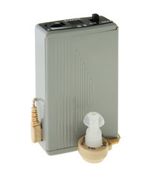Contact No:(0241) 2325424 / 2325425
Contact No:(0241) 2325424 / 2325425

Worn in a pocket or harness at chest level. It consists of the body of the hearing aid containing the microphone, amplifier and controls. A cord transmits the electrical output to a receiver, which converts this signal into sound. The receiver is attached to a mould, which holds it in place.

The body of the instrument is worn behind the ear. It ‘hooks’ over the pinna. It is attached via plastic tubing to an earmould, which holds it in place in the ear. On larger models, controls are easy to manipulate. Earmold can be easily cleaned. Accommodates larger batteries, so it's easier to handle.

It covers the concha portion of pinna. This offers more room for features such as telecoil, directional microphone, and volume control. Less of a plugged-up feeling when vented. Relatively easy to insert. This type of hearing aid is visible.

This type of hearing aid fits into the ear canal. It is barely visible, less of a plugged-up feeling since the aid sits deep in the canal. Larger units can include directional microphones.These models are susceptible to moisture and wax buildup. The battery tends to be smaller, so battery life is relatively short. May be challenging to handle and adjust.

This hearing aid fits deep and tight in the ear, which might prevent whistling feedback when used with a phone. Because it's in the canal, it has low visibility and is easy to remove. Plus, this style of hearing aid is less sensitive to wind noise.
A well recognized hearing treatment for conductive and mixed hearing losses since 1977 , As well as Single Sided Deafness (SSD). A sound processor picks up sound vibrations.An abutment is attached to the sound processor and the implant. The abutment transfers the sound vibrations from the processor to the implant.Titanium implant is placed in the mastoid process, where it fuses with the living bone (osseointegration). The implant transfers the sound vibrations to the functioning cochlea. This creates direct (percutaneous) bone conduction. In contrast, traditional BC hearing aids connect indirectly to the bone through unbroken skin (transcutaneous) and work by exerting pressure against the skull



Gajanan Hospital ENT Clinic is one of the leading centers for the treatment of diseases of the ear, nose and throat in the Ahmednagar. Established by Dr. Gajanan Kashid in 2007.The service of humanity with the highest standards of ethics and professionalism. The clinic has many firsts to its credit: